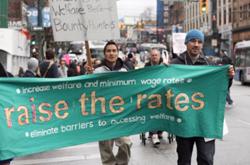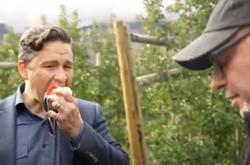Even the most dedicated anti-plastic advocate would have a hard time eliminating the toxic stuff from every facet of their life. One of the more intractable sources is right underfoot: shoes.
And we wear a lot of them. The average American bought seven pairs of shoes in 2018. People spend more money on shoes than ever before, with global revenue soaring to US$382 billion in 2022. That year, the U.S. market alone saw US$86 billion in revenue, with an estimated 2.7 billion pairs imported into the country. Almost all of them contained some kind of plastic.
That wasn’t always the case. For millennia, shoes were made of natural materials like wood, twine and leather. The story of modern footwear, however, is one in which a walk around the block can leave behind invisible pollutants. It’s a story of what designer Bill McDonough has called “monstrous hybrids”: synthetic fibres, foams and rubbers bound together in complex and hard-to-recycle constructions, all causing persistent and pernicious environmental effects as they get worn down and thrown away. But what exactly are those effects? And what can we do about them?
A petrochemical romance
The histories of industrial materials and footwear have been intertwined since at least the late 1880s, when — according to historian Thomas Turner’s book The Sports Shoe — “competition between [shoe] manufacturers was fierce.” The increasing popularity of outdoor sports, particularly lawn tennis, “created a need for suitable footwear” that allowed people to “move effectively while also preserving the integrity of the court,” Turner writes. Vulcanized rubber had recently come to market, and manufacturers paired soles made of this material with lightweight leather and fabric uppers, catering to upper-middle-class Victorians with money and time to spare.
After the Second World War, as synthetic plastics saturated the marketplace, things started to change. In leather shoes, “you see this progression from natural leather and the sole being a true [natural] rubber, to a more processed leather that has vinyl mixed in it, and the sole being some kind of thermoplastic base,” said Ariss Grutter, co-owner of Awl Together Leather, a cobbling and leather-working shop in Vancouver.
Those thermoplastic polyurethanes, or TPUs, are generally derived from fossil fuels, and Grutter pointed out that they’re typically lighter-weight and cheaper than natural rubbers. Synthetics are also often more comfortable, which helps them sell better, Grutter suggested.
But these materials also present a challenge: when TPU gets old or worn out, “it just crumbles apart. And when that happens,” explained Grutter, “you can’t glue to it because it’s structurally unsound.” This means the entire sole needs replacing, which Grutter said can cost as much as buying a new pair.
Running a modern cobbling business means dealing with the aftermath of manufacturers’ preference for cheap but short-lived synthetics over more durable natural materials. Such synthetics can be a headache for Grutter.
“One thing we consistently cannot repair is pleather,” they said. “We see it a lot in the lining of tall boots, or mixed in with leather as a way to cut costs in production. We can’t really glue to it; we can’t [repair] it if it’s peeling.”
And when a shoe isn’t repaired — whether because it can’t be or because its owner didn’t think it could be — it’s likely to go to a landfill.
One 2007 study found that 85 per cent of used shoes in the United Kingdom were sent to the dump rather than recycled or reused. It’s bad enough that the plastics inside most shoes are derived from fossil fuels; once they’re in the landfill, shoe plastics degrade as they’re exposed to sunlight and release ethylene and methane, two potent greenhouse gases.
Compound concerns
Plastic shoes aren’t only a source of pollution when they’re disposed of, though. Recent studies have found that shoes can also be a source of microplastic pollution as we wear them.
A real-world wear test that measured how much plastic soles wore down over time was conducted five years ago by a group of environmental science master’s students at the University of California, Santa Barbara.
The students estimated that between 9,000 and 400,000 tonnes of microplastics are released from shoes globally per year from regular use. In a video about the study, team member Andrea Cheung explained that the lower bound of their estimate — 9,000 tonnes — is roughly the same mass as the first three floors of the Empire State Building, while 400,000 tonnes is like the entire building plus 20 more floors.
In a study at Australia’s University of New England, researchers led by PhD candidate Nicola Forster found that trail running events deposit significant plastic fibres and rubber fragments onto soil and rock surfaces in conservation and wilderness areas. They estimate that 100 runners release about 425,000 rubber particles over a 10-kilometre race. These particles ranged in size from 20 microns — about the width of a thin human hair — to 500 microns, the size of a coarse sand grain. With trail running gaining popularity, big events might contribute a huge increase in plastic pollution in protected wilderness areas, the study suggests.
The journal Environmental Science and Technology published an opinion piece last year calling for plastics to be classified as “persistent, bioaccumulative and toxic,” or PBT, pollutants. According to the opinion’s 22 co-authors, plastic pollution pervades and persists in all natural environments; it accumulates in aquatic organisms that directly ingest particles and/or take them in through the food chain; and it can be toxic, altering genetics, causing inflammation, changing feeding behaviour and affecting reproduction in aquatic animals. In humans, the social costs for plastic pollution are unevenly distributed, with seafood-dependent coastal communities at greater risk than other populations.
According to the article, designating plastics as PBT pollutants would help regulatory efforts to “control and eliminate the manufacture and use of harmful or toxic plastics,” among other measures.
Juan José Alava, an ocean pollution researcher at the University of British Columbia, is one of the opinion’s co-authors. He said in an interview that plastic pollution can move around the world thanks to air and ocean currents. “Because the density of plastic is very low, [particles] can be transported by the wind,” he explained. “That’s why you find pollutants in the Arctic, in Antarctica, and even the Galapagos Islands.” An estimated 170 trillion plastic particles are floating on the surface of the world’s oceans, in what researchers have dubbed a “plastic smog.”
The Australian study mentions research that shows plastic particles can indeed be moved around by wind, or end up in groundwater, lakes and rivers. Another study by Forster showed that microplastics on soil “remain relatively immobile” in the rain, suggesting that particles from shoes can also persist in the environment surrounding trails.
What happens to the soil that takes in that plastic? Researchers at Konkuk University in Seoul, South Korea, studied how different types of shoe fragments affected mung bean plants and the soil they grew in. They found that sneaker sole fragments reduced the soil’s capacity to hold water and leached benzothiazole, a common additive to synthetic rubbers known to inhibit plant growth.
Downstream, there are also disturbing effects. UBC’s Alava pointed to how microplastic accumulation in marine birds causes plasticosis, a disease where persistent inflammation from plastic in the gastrointestinal tract causes internal scarring and tissue deformation. This affects their ability to grow, digest food and ultimately survive.
Industry responses
The footwear industry has seen a surge of small brands like Nothing New and Blueview exploring different methods of making shoes more sustainably, including using post-consumer recycled materials in uppers, laces and labels, or constructing shoes from industrially compostable materials. These companies make up only a tiny proportion of the market, though.
The biggest brands have also taken some action by making products out of recycled plastics and launching return and recycling programs. But these efforts have been far from robust.
Since 1992, Nike’s Reuse-A-Shoe program has enabled customers to bring their used shoes to a Nike retail location, from which the shoes are shipped off to a recycling centre to be processed into materials for track surfaces and future Nike shoes and garments.
Over its 31-year run, Reuse-A-Shoe has recycled an estimated 28 million pairs of shoes. But that number pales compared with what Nike produces. In 2005 alone, the company sold an estimated 12 million pairs of just a single shoe model: the Air Force One.
Beyond its low volume, Reuse-A-Shoe has other shortcomings. A 2019 assessment by researchers at the University of Queensland suggested that “the actual effectiveness of this program in limiting Nike’s environmental impact is not clear,” adding that “the major issue, which potentially offsets the environmental gains made by Reuse-A-Shoe, is the greenhouse gas emissions associated with transportation of goods to the recycling facilities.”
In 2020 Nike put the program on pause following COVID-induced retail closures, and in 2021 it shut it down entirely in the United Kingdom as Brexit raised costs about 30 per cent. The Nike website says that Reuse-A-Shoe “may still be found at most Nike stores” in other countries and directs customers to contact their local store to check.
Meanwhile, Nike’s major competitor Adidas announced a shoe in 2015 made from “ocean plastic,” referring to plastic bottles gathered from polluted shorelines. In 2021 it also released a fully recyclable shoe, which has since been expanded into a line of clothes and shoes called “Made to Be Remade.” The intent was to create products made from a single material that could be ground up and remade into more of the same product.
In 2020 Adidas reported that “more than half of all the polyester” in its products was recycled polyester. And in 2022 the company said it produced approximately 27 million pairs of shoes using the aforementioned intercepted plastic.
But the exact proportion of diverted plastic used in those shoes remains unclear. And despite the “ocean plastic” branding, the program does not involve recovering plastic from aquatic environments, only the shore. Furthermore, the British investigative news show Dispatches found that Adidas had been sourcing some plastic from bottles collected at a luxury resort in the Maldives, not on any shoreline.
A renewed culture of repair
With solutions on the manufacturing side that don’t seem sufficient to the problem, are there actions individuals can take? On the microplastic pollution side of things, shoppers can opt out entirely by buying leather- or wooden-soled shoes — but at the expense of availability, affordability and comfort.
In the context of trail running, the University of New England scientists recommend avoiding sensitive wilderness areas and high-abrasion surfaces — like rock and steep inclines — to stem the flow of microplastics into delicate ecosystems. Other scholars looking into this issue recommend regular cleaning of trail surfaces, which could be done by volunteer crews.
To reduce the quantity of plastic shoe waste overall, individuals can endeavour to give their shoes the longest life possible. A shoe repair renaissance would see the practice of getting shoes fixed when they’re worn out replace the cradle-to-grave model that modern footwear — and indeed, most modern consumer goods — currently follow.
One way to ease that process is to buy shoes whose manufacturer makes getting them repaired easy. Birkenstock, for example, makes all parts of their product available for cobblers to purchase. “I can buy a footbed, the buckles, the soling materials, and I can repair a Birkenstock a thousand times over,” said Grutter.
Even if Birkenstocks don’t fit your style or budget, repair may still be an option. “Cobbling has decreased in popularity,” said Grutter. “So people don’t entirely know what is possible.” Instead of assuming that worn-out goods have only one possible destiny, we can start by checking if they can be fixed.
“A lot of people who buy fast-fashion shoes don’t realize that those actually can be repaired,” said Grutter. “I can patch, resole, reglue. I would encourage people to go speak to your local cobbler.”
This article is third in an Asparagus Magazine series made possible by a Vancity Community Branch Grant about reducing plastic in our lives. Read the first story, “7 Ways to Cut Plastic at Home,” on the Asparagus website. ![]()
Read more: Labour + Industry, Environment

















Tyee Commenting Guidelines
Comments that violate guidelines risk being deleted, and violations may result in a temporary or permanent user ban. Maintain the spirit of good conversation to stay in the discussion and be patient with moderators. Comments are reviewed regularly but not in real time.
Do:
Do not: